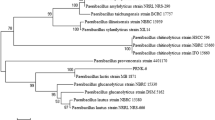Abstract
A strain of Mycobacterium flavescens was isolated from polluted sediments. It was capable of utilizing pyrene as a sole source of carbon and energy. When pyrene was supplied as a suspension at 50 μg/ml, the generation time was 9.6 h and the rate of pyrene utilization was 0.56 μg ml-1 day-1. In addition to pyrene, the strain could mineralize phenanthrene (17.7%) and fluoranthene (17.9%), but failed to mineralize naphthalene, chrysene, anthracene, fluorene, acenaphthene and benzo[a]pyrene, as determined by recovery of radiolabeled CO2 in incubations conducted for 2 weeks under growth conditions. Metabolites produced during growth on pyrene were detected and characterized by HPLC and GC-MS. The product of initial ring oxidation, 4,5-dihydroxy-4,5-dihydropyrene was identified, as well as ring-fission products including 4-phenanthroic acid, phthalic acid, and 4,5-phenanthrenedioic acid.
Similar content being viewed by others
Author information
Authors and Affiliations
Additional information
Received: 3 October 1995/Received last revision: 1 April 1996/Accepted: 15 April 1996
Rights and permissions
About this article
Cite this article
Dean-Ross, D., Cerniglia, C. Degradation of pyrene by Mycobacterium flavescens . Appl Microbiol Biotechnol 46, 307–312 (1996). https://doi.org/10.1007/s002530050822
Issue Date:
DOI: https://doi.org/10.1007/s002530050822




